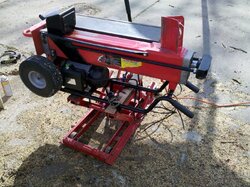bspooky said:Well rats. I think this Earthquake is the same or similar to the other 4-5 ton splitters, I looked at a couple before picking it up at Menards. Unfortunately, it isn't working out for me. Went through some ash easily enough, but the reason I am looking at these is for splitting some elm and oak I am not able to split with the smart log splitter. This won't split those either. Just puts a dent in the wood and stops. One piece I got to split by rotating, but that is it. I even tried letting the bleed screw out even more, but no luck.
The harbor freight that started this is a 2 HP motor, these 4-5 tons are 1.75 HP, so that may not be the answer. But I see the Powerhosue and the Pow "R" kraft 7 tons are 3 HP motors. So maybe they are true 7 tons, who knows.
I don't want to go gas (noise, fumes, I like electric stuff) and the only electric log splitters I can find over 7 tons are the ram splitters at I think 12 ton, but they are then large in size too (I have storage issues, LOL)
color me sad
Just a thought: are you using a 10-gauge cord, no longer than 25 feet? That will deliver all the juice the splitter needs. Higher gauge or longer length can reduce power.


